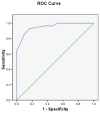A pilot study using the Gynecologic Cancer Lymphedema Questionnaire (GCLQ) as a clinical care tool to identify lower extremity lymphedema in gynecologic cancer survivors
- PMID: 20163847
- PMCID: PMC4847724
- DOI: 10.1016/j.ygyno.2010.01.022
A pilot study using the Gynecologic Cancer Lymphedema Questionnaire (GCLQ) as a clinical care tool to identify lower extremity lymphedema in gynecologic cancer survivors
Abstract
Objective: This study aimed to determine the feasibility and efficacy of using the Gynecologic Cancer Lymphedema Questionnaire (GCLQ) as a symptom scale for lymphedema of the lower extremity (LLE).
Methods: Twenty-eight gynecologic cancer survivors with documented LLE and 30 without a history or presence of lymphedema completed the GCLQ and provided feedback about their satisfaction with and feasibility of using the GCLQ at their oncology follow-ups. The study survey took approximately 5-10 min to complete, and it was easily understood by the majority of the sample.
Results: Participants had a mean age of 59.6 years (range, 28-80 years). Twenty-eight women (48%) had LLE, and 30 (52%) had no history or presence of LLE (confirmed by limb volume [LV] measurements at assessment). Type of cancer history included endometrial, 38 (66%); cervical, 13 (22%); and vulvar, 7 (12%). GCLQ scores differed significantly by lymphedema diagnosis; LLE patients had higher scores (P<0.01). The large area under the curve (AUC) of 0.95 (95% CI: 0.90-1.000) suggests that the GCLQ can distinguish between patients with and without LLE. Although all 28 (100%) of the LLE patients were aware of their LLE diagnosis, only 23 (82%) underwent treatment. The GCLQ was easily understood by most (55/58, 95%), and overall, patients showed a high willingness (56/58, 96%) to complete the questionnaire at future appointments. Twenty-five (88%) of the LLE patients found the GCLQ to be helpful in identifying symptoms of lymphedema.
Conclusions: The GCLQ effectively distinguished between gynecologic cancer survivors with and those without LLE, with good sensitivity and specificity. The patients, particularly those with LLE, showed high confidence in the GCLQ's ability to detect LLE symptoms.
Copyright (c) 2010 Elsevier Inc. All rights reserved.
Conflict of interest statement
Jeanne Carter, PhD: no conflicts of interest to declare
Leigh Raviv, BA: no conflicts of interest to declare
Kathleen Appollo, RN: no conflicts of interest to declare
Alexia Iasonos, PhD: no conflicts of interest to declare
Raymond E. Baser, MS: no conflicts of interest to declare
Richard R. Barakat, MD: no conflicts of interest to declare
Figures
Similar articles
-
GOG 244 - The LymphEdema and Gynecologic cancer (LEG) study: The association between the gynecologic cancer lymphedema questionnaire (GCLQ) and lymphedema of the lower extremity (LLE).Gynecol Oncol. 2019 Dec;155(3):452-460. doi: 10.1016/j.ygyno.2019.09.027. Epub 2019 Oct 31. Gynecol Oncol. 2019. PMID: 31679787 Free PMC article.
-
Lower extremity edema in patients with early ovarian cancer.J Ovarian Res. 2014 Mar 7;7:28. doi: 10.1186/1757-2215-7-28. J Ovarian Res. 2014. PMID: 24602386 Free PMC article. Review.
-
Lower extremity lymphedema in patients with gynecologic cancer: Validation of the Gynecologic Cancer Lymphedema Questionnaire (GCLQ) in German language and investigation of lymphedema real-world treatment.Arch Gynecol Obstet. 2025 Apr;311(4):1151-1162. doi: 10.1007/s00404-024-07886-4. Epub 2024 Dec 23. Arch Gynecol Obstet. 2025. PMID: 39715839 Free PMC article.
-
Development and evaluation of the Korean version of the Gynecologic Cancer Lymphedema Questionnaire in gynecologic cancer survivors.Gynecol Oncol. 2014 Apr;133(1):111-6. doi: 10.1016/j.ygyno.2014.01.040. Epub 2014 Feb 9. Gynecol Oncol. 2014. PMID: 24522267
-
GOG 244 - The Lymphedema and Gynecologic cancer (LeG) study: The impact of lower-extremity lymphedema on quality of life, psychological adjustment, physical disability, and function.Gynecol Oncol. 2021 Jan;160(1):244-251. doi: 10.1016/j.ygyno.2020.10.023. Epub 2020 Oct 24. Gynecol Oncol. 2021. PMID: 33109392 Free PMC article. Review.
Cited by
-
The prevalence of lymphedema symptoms among survivors of long-term cancer with or at risk for lower limb lymphedema.Am J Phys Med Rehabil. 2013 Mar;92(3):223-31. doi: 10.1097/PHM.0b013e31826edd97. Am J Phys Med Rehabil. 2013. PMID: 23069748 Free PMC article.
-
GOG 244 - The LymphEdema and Gynecologic cancer (LEG) study: The association between the gynecologic cancer lymphedema questionnaire (GCLQ) and lymphedema of the lower extremity (LLE).Gynecol Oncol. 2019 Dec;155(3):452-460. doi: 10.1016/j.ygyno.2019.09.027. Epub 2019 Oct 31. Gynecol Oncol. 2019. PMID: 31679787 Free PMC article.
-
Translation and cross-cultural adaptation of the Gynecologic Cancer Lymphedema Questionnaire and the Lower Extremity Lymphedema Screening Questionnaire.Int J Gynecol Cancer. 2023 Feb 6;33(2):231-235. doi: 10.1136/ijgc-2022-003979. Int J Gynecol Cancer. 2023. PMID: 36600491 Free PMC article.
-
Impact of time elapsed since diagnosis on neuropathic symptoms, sexual function, lymphedema, and overall quality of life in ovarian cancer survivors (KGOG 3068).Obstet Gynecol Sci. 2025 Jul;68(4):304-312. doi: 10.5468/ogs.24338. Epub 2025 Jul 2. Obstet Gynecol Sci. 2025. PMID: 40602759 Free PMC article.
-
Lower extremity edema in patients with early ovarian cancer.J Ovarian Res. 2014 Mar 7;7:28. doi: 10.1186/1757-2215-7-28. J Ovarian Res. 2014. PMID: 24602386 Free PMC article. Review.
References
-
- Lymphoedema Framework. International consensus. London: MEP Ltd; 2006. Best Practice for the Management of Lymphoedema.
-
- International Society of Lymphology. The diagnosis and treatment of peripheral lymphedema. Consensus document of the International Society of Lymphology. Lymphology. 2003;36:84–91. - PubMed
-
- Badger C, Preston N, Seers K, Mortimer P. Physical therapies for reducing and controlling lymphoedema of the limbs. Cochrane Database Syst Rev. 2004;(4):CD003141. - PubMed
-
- International Society of Lymphology. The diagnosis and treatment of peripheral lymphedema. 2009 Consensus Document of the International Society of Lymphology. Lymphology. 2009;42:51–60. - PubMed
-
- Petrek JA, Senie RT, Peters M, Rosen PP. Lymphedema in a cohort of breast carcinoma survivors 20 years after diagnosis. Cancer. 2001;92:1368–77. - PubMed
MeSH terms
Grants and funding
LinkOut - more resources
Full Text Sources
Medical


